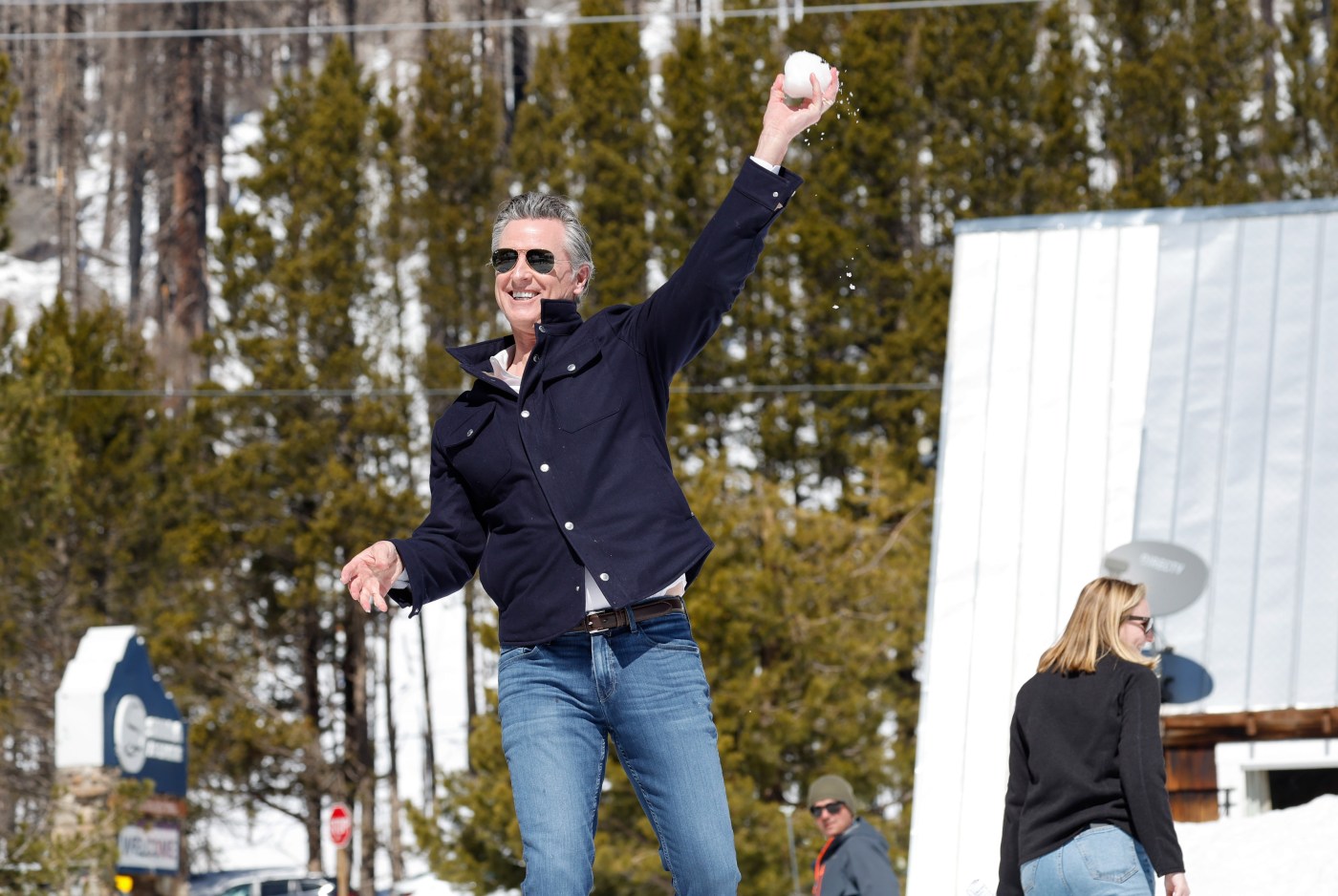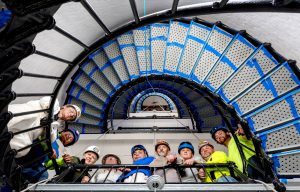Sporting snowshoes and stylish shades, Gov. Gavin Newsom on Tuesday trundled around a summit south of Lake Tahoe with state water officials to unveil a “roadmap to resilience” for the state’s fickle water supply and to confirm good news from an army of sensors scattered throughout the Sierra: California’s end-of-season snowpack haul is blessedly above normal.
The crucial April reading clocked in at 110% of normal, state water officials said Tuesday — a harbinger of a reliable water supply during the upcoming dry summer months. Last year, the April snowpack reading hit an astounding 244% of normal, but the previous three years’ snowpacks were all considerably below normal as California suffered through drought conditions.
That “weather whiplash” driven by climate change was a reminder that there is no time to get greedy, Newsom said, even with many of California’s biggest reservoirs brimming with higher-than-usual water levels providing yet more good news about the water outlook for 2024.
“You can take a deep breath this year, but don’t quadruple the amount of time in your shower,” Newsom warned Californians from Phillips Station near Echo Summit. “Consider that this time next year, we may be in a different place.”
“Extremes are becoming the new reality, and that new reality requires a new approach,” the governor said as he touted a five-year update to the California Water Plan, vowing that the Golden State would not sit idly by as “victims of fate” in the face of the oncoming climate crisis.
Newsom’s plan puts a fresh focus on a variety of new water sources, from major infrastructure projects such as the controversial Delta tunnels project to send water under the Sacramento-San Joaquin River Delta to Southern California, and the Sites Reservoir, a $4.5 billion project in Colusa County that would become the largest new reservoir anywhere in California in the past 50 years.
“We’re fast tracking them in the new permitting regime that we promoted,” Newsom said.
(Left to right) California Department of Water Resources Director Karla Nemeth, California Natural Resources Agency Secretary Wade Crowfoot and Gov. Gavin Newsom join the snow survey team for fourth media snow survey of the 2024 season is held at Phillips Station in the Sierra Nevada. The survey was held in El Dorado County on April 2, 2024.(Andrew Nixon / California Department of Water Resources)
The plan also calls for restoring ecosystems to improve the resilience of “natural infrastructure” such as aquifers and floodplains along rivers and streams. It also for the first time includes a chapter on Native American water management, which calls for state policies that improve “Tribes’ ability to access their sacred sites, protect their cultural resources, and support their water rights.”
Water experts say that Newsom’s newly released water plan could be useful guidance to local water agencies as they think about how to develop their projects, but it’s important to not over-inflate its significance. Most of the real action when it comes to building new projects takes place at the local level.
Jay Lund, a professor of civil and environmental engineering at UC Davis, said that even California’s biggest new push for expanding its water supply — the planned construction of the Sites Reservoir — came from a local initiative, not a state push.
“The (state’s) fundamental mission is not building huge (water) infrastructure,” Lund said. “Most water management is done locally, and I think they (the state) understand it.”
In this photo provided by Big Bear Mountain Resort, fresh snow covers the ski resort in Big Bear Lake, Calif., on Monday, April 1, 2024. The area has received two feet of new snow since Saturday with skiing expected to continue well into April. (Lee Stockwell/Big Bear Mountain Resort via AP)
Newsom pointed to climate change as a major challenge to the state’s ability to keep water supplies steady throughout the year. One troubling development is that the elevation at which snow accumulates in the Sierra, known as the “snow line,” has risen by about 500 feet due to climate change, experts say. And a Bay Area News Group analysis last year found that the average Sierra snowpack dropped several inches since the 1950s as the climate has warmed.
Even this year, when our total snowpack topped normal, our day-to-day weather patterns were still highly erratic, toggling from very dry conditions early in the season to a snow bonanza in March.
This year, the state hit the water jackpot. The above-average snowpack balance strikes a happy medium between too much snow, which can lead to flooding as the state’s frozen reservoir melts, and too little snow, which could plunge the state back into drought conditions.
California Department of Water Resources Snow Surveys and Water Supply Forecasting Unit Water Engineers Andy Reising, right, and Anthony Burdock conduct the fourth media snow survey of the 2024 season at Phillips Station in the Sierra Nevada. Gov. Gavin Newsom, center, and California Natural Resources Agency Secretary Wade Crowfoot watch the process. The survey was held in El Dorado County on April 2, 2024. (Fred Greaves / California Department of Water Resources)
As to what comes next for California’s water supply, California Department of Water Resources State Climatologist Michael Anderson said that it’s still hard to predict if the state is in for more accumulation this spring or if things will peter out from here.
The National Weather Service recently issued a snow advisory from 11 p.m. Wednesdays through 11 p.m. Friday for the Sierra as forecasts have begun to pick up on new storms expected to dump several inches of fresh snow to many parts of the Sierra, according to Sacramento National Weather Service meteorologist Eric Kurth.
“If people do have weekend plans (in the Sierra), just be aware, even through 11 p.m. Friday, that there could be some chain controls and slow travel,” Kurth said.
Some areas near Interstate 80 South could get five to 10 inches of snowfall, and south of Highway 50 near Lake Tahoe could get six to 12 inches, Kurth said. The usually cold temperatures forecast for the approaching storm system could mean that snow flurries pop up even at lower elevations in the Sierra foothills.












